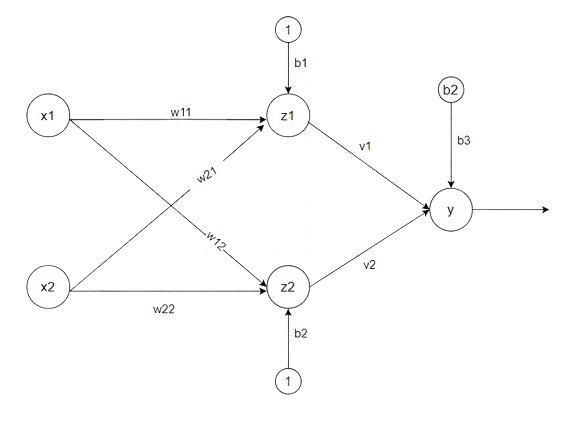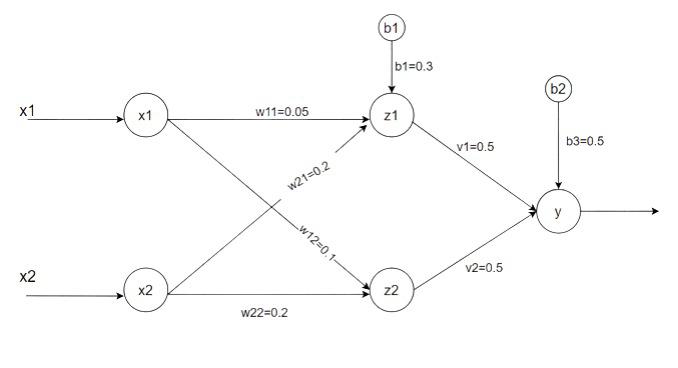An artificial neural network inspired by the human neural system is a network used to process the data which consist of three types of layer i.e input layer, the hidden layer, and the output layer. The basic neural network contains only two layers which are the input and output layers. The layers are connected with the weighted path which is used to find net input data. In this section, we will discuss two basic types of neural networks Adaline which doesn’t have any hidden layer, and Madaline which has one hidden layer.
1. Adaline (Adaptive Linear Neural) :
- A network with a single linear unit is called Adaline (Adaptive Linear Neural). A unit with a linear activation function is called a linear unit. In Adaline, there is only one output unit and output values are bipolar (+1,-1). Weights between the input unit and output unit are adjustable. It uses the delta rule i.e
 , where
, where 
 and
and  are the weight, predicted output, and true value respectively.
are the weight, predicted output, and true value respectively. - The learning rule is found to minimize the mean square error between activation and target values. Adaline consists of trainable weights, it compares actual output with calculated output, and based on error training algorithm is applied.
Workflow:
-removebg-preview.jpg)
Adaline
First, calculate the net input to your Adaline network then apply the activation function to its output then compare it with the original output if both the equal, then give the output else send an error back to the network and update the weight according to the error which is calculated by the delta learning rule. i.e  , where
, where 
 and
and  are the weight, predicted output, and true value respectively.
are the weight, predicted output, and true value respectively.
Architecture:

Adaline
In Adaline, all the input neuron is directly connected to the output neuron with the weighted connected path. There is a bias b of activation function 1 is present.
Algorithm:
Step 1: Initialize weight not zero but small random values are used. Set learning rate α.
Step 2: While the stopping condition is False do steps 3 to 7.
Step 3: for each training set perform steps 4 to 6.
Step 4: Set activation of input unit xi = si for (i=1 to n).
Step 5: compute net input to output unit

Here, b is the bias and n is the total number of neurons.
Step 6: Update the weights and bias for i=1 to n

and calculate

when the predicted output and the true value are the same then the weight will not change.
Step 7: Test the stopping condition. The stopping condition may be when the weight changes at a low rate or no change.
Implementations
Problem: Design OR gate using Adaline Network?
Solution :
- Initially, all weights are assumed to be small random values, say 0.1, and set learning rule to 0.1.
- Also, set the least squared error to 2.
- The weights will be updated until the total error is greater than the least squared error.
- Calculate the net input

 (when x1=x2=1)
(when x1=x2=1)
- Now compute, (t-yin)=(1-0.3)=0.7
- Now, update the weights and bias


- calculate the error

Similarly, repeat the same steps for other input vectors and you will get.
| x1 | x2 | t | yin | (t-yin) | ∆w1 | ∆w2 | ∆b | w1 (0.1) | w2 (0.1) | b (0.1) | (t-yin)^2 |
| 1 | 1 | 1 | 0.3 | 0.7 | 0.07 | 0.07 | 0.07 | 0.17 | 0.17 | 0.17 | 0.49 |
| 1 | -1 | 1 | 0.17 | 0.83 | 0.083 | -0.083 | 0.083 | 0.253 | 0.087 | 0.253 | 0.69 |
| -1 | 1 | 1 | 0.087 | 0.913 | -0.0913 | 0.0913 | 0.0913 | 0.1617 | 0.1783 | 0.3443 | 0.83 |
| -1 | -1 | -1 | 0.0043 | -1.0043 | 0.1004 | 0.1004 | -0.1004 | 0.2621 | 0.2787 | 0.2439 | 1.01 |
This is epoch 1 where the total error is 0.49 + 0.69 + 0.83 + 1.01 = 3.02 so more epochs will run until the total error becomes less than equal to the least squared error i.e 2.
Python3
import numpy as np
def Adaline(Input, Target, lr=0.2, stop=0.001):
weight = np.random.random(Input.shape[1])
bias = np.random.random(1)
Error=[stop +1]
while Error[-1] > stop or Error[-1]-Error[-2] > 0.0001:
error = []
for i in range(Input.shape[0]):
Y_input = sum(weight*Input[i]) + bias
for j in range(Input.shape[1]):
weight[j]=weight[j] + lr*(Target[i]-Y_input)*Input[i][j]
bias=bias + lr*(Target[i]-Y_input)
error.append((Target[i]-Y_input)**2)
Error.append(sum(error))
print('Error :',Error[-1])
return weight, bias
x = np.array([[1.0, 1.0, 1.0],
[1.0, -1.0, 1.0],
[-1.0, 1.0, 1.0],
[-1.0, -1.0, -1.0]])
t = np.array([1, 1, 1, -1])
w,b = Adaline(x, t, lr=0.2, stop=0.001)
print('weight :',w)
print('Bias :',b)
|
Output:
Error : [2.33228319]
Error : [1.09355784]
Error : [0.73680883]
Error : [0.50913731]
Error : [0.35233593]
Error : [0.24384625]
Error : [0.16876305]
Error : [0.11679891]
Error : [0.08083514]
Error : [0.05594504]
Error : [0.0387189]
Error : [0.02679689]
Error : [0.01854581]
Error : [0.01283534]
Error : [0.00888318]
Error : [0.00614795]
Error : [0.00425492]
Error : [0.00294478]
Error : [0.00203805]
Error : [0.00141051]
Error : [0.0009762]
weight : [0.01081771 0.01081771 0.98675106]
Bias : [0.01081771]
Predictions:
Predict from the evaluated weight and bias of Adaline
Python3
def prediction(X,w,b):
y=[]
for i in range(X.shape[0]):
x = X[i]
y.append(sum(w*x)+b)
return y
prediction(x,w,b)
|
output:
[array([1.0192042]),
array([0.99756877]),
array([0.99756877]),
array([-0.99756877])]
2. Madaline (Multiple Adaptive Linear Neuron) :
- The Madaline(supervised Learning) model consists of many Adaline in parallel with a single output unit. The Adaline layer is present between the input layer and the Madaline layer hence Adaline layer is a hidden layer. The weights between the input layer and the hidden layer are adjusted, and the weight between the hidden layer and the output layer is fixed.
- It may use the majority vote rule, the output would have an answer either true or false. Adaline and Madaline layer neurons have a bias of ‘1’ connected to them. use of multiple Adaline helps counter the problem of non-linear separability.
Architecture:

Madaline
There are three types of a layer present in Madaline First input layer contains all the input neurons, the Second hidden layer consists of an adaline layer, and weights between the input and hidden layers are adjustable and the third layer is the output layer the weights between hidden and output layer is fixed they are not adjustable.
Algorithm:
Step 1: Initialize weight and set learning rate α.
v1=v2=0.5 , b=0.5
other weight may be a small random value.
Step 2: While the stopping condition is False do steps 3 to 9.
Step 3: for each training set perform steps 4 to 8.
Step 4: Set activation of input unit xi = si for (i=1 to n).
Step 5: compute net input of Adaline unit
zin1 = b1 + x1w11 + x2w21
zin2 = b2 + x1w12 + x2w22
Step 6: for output of remote Adaline unit using activation function given below:
Activation function f(z) = .
.
z1=f(zin1)
z2=f(zin2)
Step 7: Calculate the net input to output.
yin = b3 + z1v1 + z2v2
Apply activation to get the output of the net
y=f(yin)
Step 8: Find the error and do weight updation
if t ≠ y then t=1 update weight on z(j) unit whose next input is close to 0.
if t = y no updation
wij(new) =wij(old) + α(t-zinj)xi
bj(new) = bj(old) + α(t-zinj)
if t=-1 then update weights on all unit zk which have positive net input
Step 9: Test the stopping condition; weights change all number of epochs.
Problem: Using the Madaline network, implement XOR function with bipolar inputs and targets. Assume the required parameter for the training of the network.
Solution :
- Training pattern for XOR function :
- Initially, weights and bias are: Set α = 0.5
[w11 w21 b1] = [0.05 0.2 0.3]
[w12 w22 b2] = [0.1 0.2 0.15]
[v1 v2 v3] = [0.5 0.5 0.5]

Madaline
- for the first i/p & o/p pair from training data :
x1 = 1 x2 = 1 t = -1 α = 0.5
- Net input to the hidden unit :
zin1 = b1 + x1w11 + x2w21 = 0.05 * 1 + 0.2 *1 + 0.3 = 0.55
zin2 = b2 + x1w12 + x2w22 = 0.1 * 1 + 0.2 *1 + 0.15 = 0.45
- Apply the activation function f(z) to the net input
z1 = f(zin1) = f(0.55) = 1
z2 = f(zin2) = f(0.45) = 1
- computation for the output layer
yin = b3 + z1v1 + z2v2 = 0.5 + 1 *0.5 + 1*0.5 = 1.5
y=f(yin) = f(1.5) = 1
- Since (y=1) is not equal to (t=-1) update the weights and bias
wij(new) =wij(old) + α(t-zinj)xi
bj(new) = bj(old) + α(t-zinj)
- w11(new) = w11(old) + α(t-zin1)x1 = 0.05 + 0.5(-1-0.55) * 1 = -0.725
w12(new) = w12(old) + α(t-zin2)x1 = 0.1 + 0.5(-1-0.45) * 1 = -0.625
b1(new) = b1(old) + α(t-zin1) = 0.3 + 0.5(-1-0.55) = -0.475
w21(new) = w21(old) + α(t-zin1)x2 = 0.2 + 0.5(-1-0.55) * 1 = -0.575
w22(new) = w22(old) + α(t-zin2)x2 = 0.2 + 0.5(-1-0.45) * 1 = -0.525
b2(new) = b2(old) + α(t-zin2) = 0.15 + 0.5(-1-0.45) = -0.575
So, after epoch 1 weight like :
[w11 w21 b1] = [-0.725 -0.575 -0.475]
[w12 w22 b2] = [-0.625 -0.525 -0.575]
Python3
import numpy as np
import pandas as pd
def activation_fn(z):
if z>=0:
return 1
else:
return -1
def Madaline(Input, Target, lr, epoch):
weight = np.random.random((Input.shape[1],Input.shape[1]))
bias = np.random.random(Input.shape[1])
w = np.array([0.5 for i in range(weight.shape[1])])
b = 0.5
k = 0
while k<epoch:
error = []
z_input = np.zeros(bias.shape[0])
z = np.zeros(bias.shape[0])
for i in range(Input.shape[0]):
for j in range(Input.shape[1]):
z_input[j] = sum(weight[j]*Input[i]) + bias[j]
z[j]= activation_fn(z_input[j])
y_input = sum(z*w) +b
y = activation_fn(y_input)
if y != Target[i]:
for j in range(weight.shape[1]):
weight[j]= weight[j] + lr*(Target[i]-z_input[j])*Input[i][j]
bias[j] = bias[j] + lr*(Target[i]-z_input[j])
error.append((Target[i]-z_input)**2)
Error = sum(error)
print(k,'>> Error :',Error)
k+=1
return weight, bias
x = np.array([[1.0, 1.0, 1.0], [1.0, -1.0, 1.0],
[-1.0, 1.0, 1.0], [-1.0, -1.0, -1.0]])
t = np.array([1, 1, 1, -1])
w,b = Madaline(x, t, 0.0001, 3)
print('weight :',w)
print('Bias :',b)
|
Output:
0 >> Error : [4.51696958 1.53996419 2.66999799]
1 >> Error : [4.51696958 1.53996419 2.66999799]
2 >> Error : [4.51696958 1.53996419 2.66999799]
weight : [[0.1379015 0.86899587 0.7513866 ]
[0.82302152 0.19126824 0.35891423]
[0.52160397 0.1238258 0.88265076]]
Bias : [0.87199879 0.43476458 0.72613887]
Predictions:
Predict from the evaluated weight and bias of Madaline
Python3
def prediction(X, w,b):
y =[]
for i in range(X.shape[0]):
x = X[i]
z1 = x*w
z_1 =[]
for j in range(z1.shape[1]):
z_1.append(activation_fn(sum(z1[j])+b[j]))
y_in = sum(np.array(z_1)*np.array([0.5 for j in range(w.shape[1])])) + 0.5
y.append(activation_fn(y_in))
return y
prediction(x, w,b)
|
Output:
[1, 1, 1, -1]
The output of the Madaline is 100% correct.
Share your thoughts in the comments
Please Login to comment...